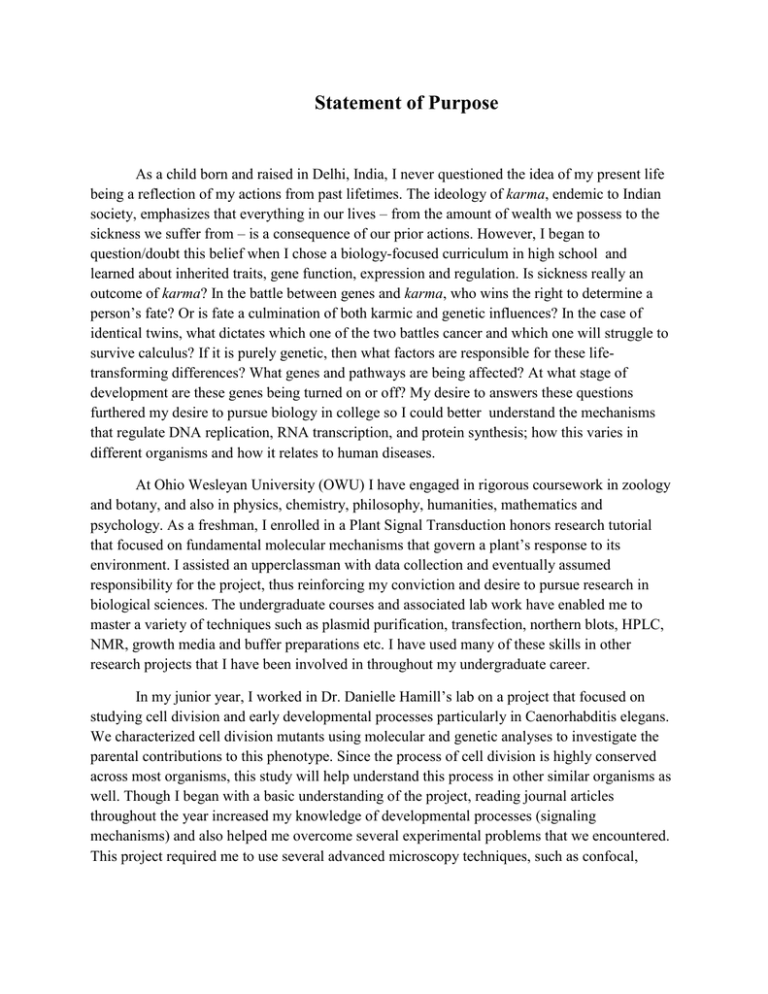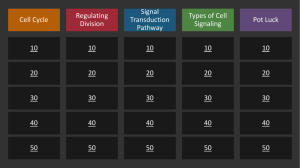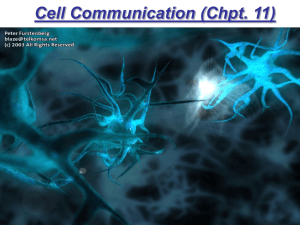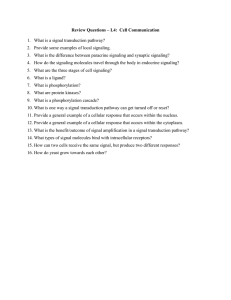Statement of Purpose - Ohio Wesleyan University
advertisement

Statement of Purpose As a child born and raised in Delhi, India, I never questioned the idea of my present life being a reflection of my actions from past lifetimes. The ideology of karma, endemic to Indian society, emphasizes that everything in our lives – from the amount of wealth we possess to the sickness we suffer from – is a consequence of our prior actions. However, I began to question/doubt this belief when I chose a biology-focused curriculum in high school and learned about inherited traits, gene function, expression and regulation. Is sickness really an outcome of karma? In the battle between genes and karma, who wins the right to determine a person’s fate? Or is fate a culmination of both karmic and genetic influences? In the case of identical twins, what dictates which one of the two battles cancer and which one will struggle to survive calculus? If it is purely genetic, then what factors are responsible for these lifetransforming differences? What genes and pathways are being affected? At what stage of development are these genes being turned on or off? My desire to answers these questions furthered my desire to pursue biology in college so I could better understand the mechanisms that regulate DNA replication, RNA transcription, and protein synthesis; how this varies in different organisms and how it relates to human diseases. At Ohio Wesleyan University (OWU) I have engaged in rigorous coursework in zoology and botany, and also in physics, chemistry, philosophy, humanities, mathematics and psychology. As a freshman, I enrolled in a Plant Signal Transduction honors research tutorial that focused on fundamental molecular mechanisms that govern a plant’s response to its environment. I assisted an upperclassman with data collection and eventually assumed responsibility for the project, thus reinforcing my conviction and desire to pursue research in biological sciences. The undergraduate courses and associated lab work have enabled me to master a variety of techniques such as plasmid purification, transfection, northern blots, HPLC, NMR, growth media and buffer preparations etc. I have used many of these skills in other research projects that I have been involved in throughout my undergraduate career. In my junior year, I worked in Dr. Danielle Hamill’s lab on a project that focused on studying cell division and early developmental processes particularly in Caenorhabditis elegans. We characterized cell division mutants using molecular and genetic analyses to investigate the parental contributions to this phenotype. Since the process of cell division is highly conserved across most organisms, this study will help understand this process in other similar organisms as well. Though I began with a basic understanding of the project, reading journal articles throughout the year increased my knowledge of developmental processes (signaling mechanisms) and also helped me overcome several experimental problems that we encountered. This project required me to use several advanced microscopy techniques, such as confocal, fluorescence and DIC to visualize whole worms, dividing embryos, spindle formation in cells etc. For the past two summers, I have contributed to a research project in Dr. Chris Wolverton’s lab. Our goal has been to examine the relationship between Phosphate (Pi) availability and lateral root gravitropism by quantitatively studying the effects of low Pi concentrations on lateral root architecture of wild-type (WT) and mutants PHT1:1 and PHT1:4 (Pi transporter genes) seedlings of Arabidopsis thaliana. In previous studies we observed that WT seedlings grown on low-Pi medium exhibited an increased gravitropic response. Our results were consistent with our hypothesis that the gravitropic response of both mutants grown in normal Pi medium will be similar to that of WT seedlings grown in low-Pi medium. Understanding this relationship, will allow us to select for plants that have higher productivity and require fewer fertilizer inputs. As part of the project, I used techniques, such as PCR (Polymerase Chain Reaction), RT-PCR, gel electrophoresis, automated image analysis, confocal microscopy, time-lapse photography etc. At the end of summer, I presented a poster at the research symposium, summarizing my results from the 10-week program. I also presented my results in a poster session at the Mid-western section meeting of ASPB (American Society of Plant Biologists). Under the guidance of Dr. Wolverton and a former OWU student, I am currently in the process of finishing up the project and documenting results that will be included in a paper that will be submitted for publication. While these experiences reaffirmed my interest in research, the Cell and Molecular Biology course helped me identify a more focused area of research. This course highlighted questions related to molecular mechanisms of eukaryotic cellular physiology. Some of the topics covered included protein structure and regulation; signal transduction; and cellular mechanisms leading to tumorigenesis. I mastered techniques such as SDS page, Northern blot, Nanodrop and Microplate spectroscopy. A very valuable experience in this class was learning to write an NIH-style grant proposal. While I wasn’t able to actually carry out the experiments, I developed a research project that focused on abnormal activation of Wnt signaling pathways and its tumorigenic effects and wrote a grant proposal to examine the interaction between Smo and Ptch proteins in this pathway. In order to design my own experiments and write a thorough and convincing proposal, I read through numerous journal articles that related the concepts we learned in class to current areas of research. Since writing grant proposals will be an integral part of my future career, this training was very useful. The course’s focus on signal transduction pathways and tumorigenesis propelled me in the direction of cancer research. My education and research experience at OWU have prepared me for a graduate program in [insert program name here]. There are many faculty members at _________ University doing research I find fascinating. For example, I am very interested in Dr. Lorainne Santy’s research on the role of GTPases in epithelial cell mobility and metastasis. The project uses many techniques that I am well acquainted with including Western Blot, transduction and transfection among others. The Santy lab’s focus on signaling mechanisms affecting cell motility is very much in line with the type of cancer research I would like to do. I want to focus on identifying novel anticancer drug targets by examining cell signaling dysfunctionalities in tumor development and translating these findings into potent therapeutics. My decision to apply to Ph.D. programs stems from my career goal of becoming an independent investigator in the field of translational cancer research. In addition to research, I am committed to having a career that enables me to mentor and lead a group of aspiring graduate level researchers. I believe that the education and opportunities that I will get as a research or teaching assistant will prepare me to successfully fulfill my career goals.




